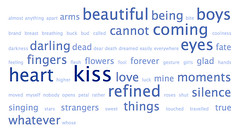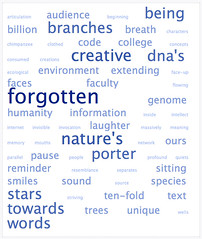I’ve been showing TagCrowd around to friends and colleagues lately (easy user testing). It’s fun to watch people get into playing with it, seeking out ever-more interesting texts, speeches or poetry to visualize and compare. It made me realize that TagCrowd needs a photo gallery of clouds, each linking to its source text.

I find that newcomers to the tag cloud are enamored by its gestalt typographic aesthetic more than anything else.
It’s beautiful information.
More than a few people have said they want a tag cloud print to hang on their walls as cybermodern art. Some want t-shirts with visualizations of their resumes. Roy Pea and I spoke yesterday about printing tag clouds on name tags for a September gathering of researchers.
Imagine walking around with a tag cloud dangling from your neck, meeting people and glancing down at their name tags to see the vocabulary of their interests and expertise. In a sense, you can see in that glance how to speak their language. Know to call a shoe a shoe. And know to ask about their interest in dolphin language or C++ compilers or Japanese architecture.

Roy always reminds me to ask, What’s missing from the model? For instance, what word should be in my tag cloud that isn’t? After all, it does not adequately sum up my life to run my CV through the TagCrowd shreddder — monotonous and academic as it may be. But it’s a start.
Cory Doctorow’s seven obstacles to meta-utopia guarantee we will never have perfect metadata. But we will have plenty of rough yet reliable approximations.
A tag cloud made from a CV may not be the most empirically rigorous way of assessing someone’s research interests, even a narrow band of them. But it’s a great approximation for being so quick and easy. A hand drawn sketch instead of a photograph; the tag cloud is information impressionism: what it lacks in exactitude, it makes up for with good looks.
Fuzzy information can be useful too, as Fred Turner told me today. You can learn a lot from a sketch.

